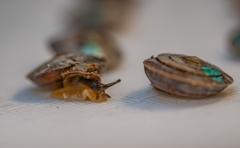The ocean has gifted science with a remarkable discovery — a deepwater fish has been officially named after San, the valiant warrior princess from Studio Ghibli's iconic animated movie, "Princess Mononoke." This new species, dubbed Branchiostegus sanae, was identified by a team of researchers from China who were struck by its distinctive facial markings, reminiscent of San's signature cheek stripes.
San, a character known for her fierce dedication to protecting her forest home, resonated deeply with audiences since the film's release in 1997, making it a massive success in Japan with box office earnings of over 19 billion yen (approximately £100.4 million). The movie, helmed by legendary director Hayao Miyazaki, explores the intricate bond between humanity and nature, a theme echoed beautifully in the naming of this new fish.
The Branchiostegus sanae is categorized as a deepwater tilefish, part of the Branchiostegidae family, which inhabits the ocean depths, sometimes reaching down to 600 meters. The research team, which included specialists from the South China Sea Institute of Oceanology and various Chinese universities, applied genetic analysis methods to confirm the species' uniqueness.
Highlighting the significance of their choice, lead author Haochen Huang spoke about San’s journey as a character. He remarked, “In Princess Mononoke, San identifies with the forest and fights for its preservation. This mirrors the relationship we wish to promote through this name." He emphasized the need for harmony between humans and nature, a message also portrayed in the film.
Despite the common presence of deepwater tilefish in seafood markets across East and Southeast Asia, the diversity within this group remains low, with only 31 recognized species in the Branchiostegidae family. The discovery of the Branchiostegus sanae is especially significant, marking a rare event since only three new species in the Branchiostegus genus have been identified in the last 34 years. Specimens of this new species will now be preserved in marine biological collections, ensuring that researchers have the opportunity to study and learn more about these fascinating creatures.
San, a character known for her fierce dedication to protecting her forest home, resonated deeply with audiences since the film's release in 1997, making it a massive success in Japan with box office earnings of over 19 billion yen (approximately £100.4 million). The movie, helmed by legendary director Hayao Miyazaki, explores the intricate bond between humanity and nature, a theme echoed beautifully in the naming of this new fish.
The Branchiostegus sanae is categorized as a deepwater tilefish, part of the Branchiostegidae family, which inhabits the ocean depths, sometimes reaching down to 600 meters. The research team, which included specialists from the South China Sea Institute of Oceanology and various Chinese universities, applied genetic analysis methods to confirm the species' uniqueness.
Highlighting the significance of their choice, lead author Haochen Huang spoke about San’s journey as a character. He remarked, “In Princess Mononoke, San identifies with the forest and fights for its preservation. This mirrors the relationship we wish to promote through this name." He emphasized the need for harmony between humans and nature, a message also portrayed in the film.
Despite the common presence of deepwater tilefish in seafood markets across East and Southeast Asia, the diversity within this group remains low, with only 31 recognized species in the Branchiostegidae family. The discovery of the Branchiostegus sanae is especially significant, marking a rare event since only three new species in the Branchiostegus genus have been identified in the last 34 years. Specimens of this new species will now be preserved in marine biological collections, ensuring that researchers have the opportunity to study and learn more about these fascinating creatures.





